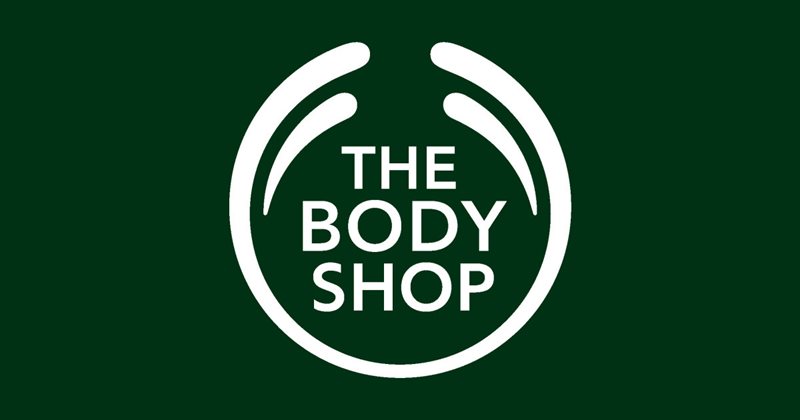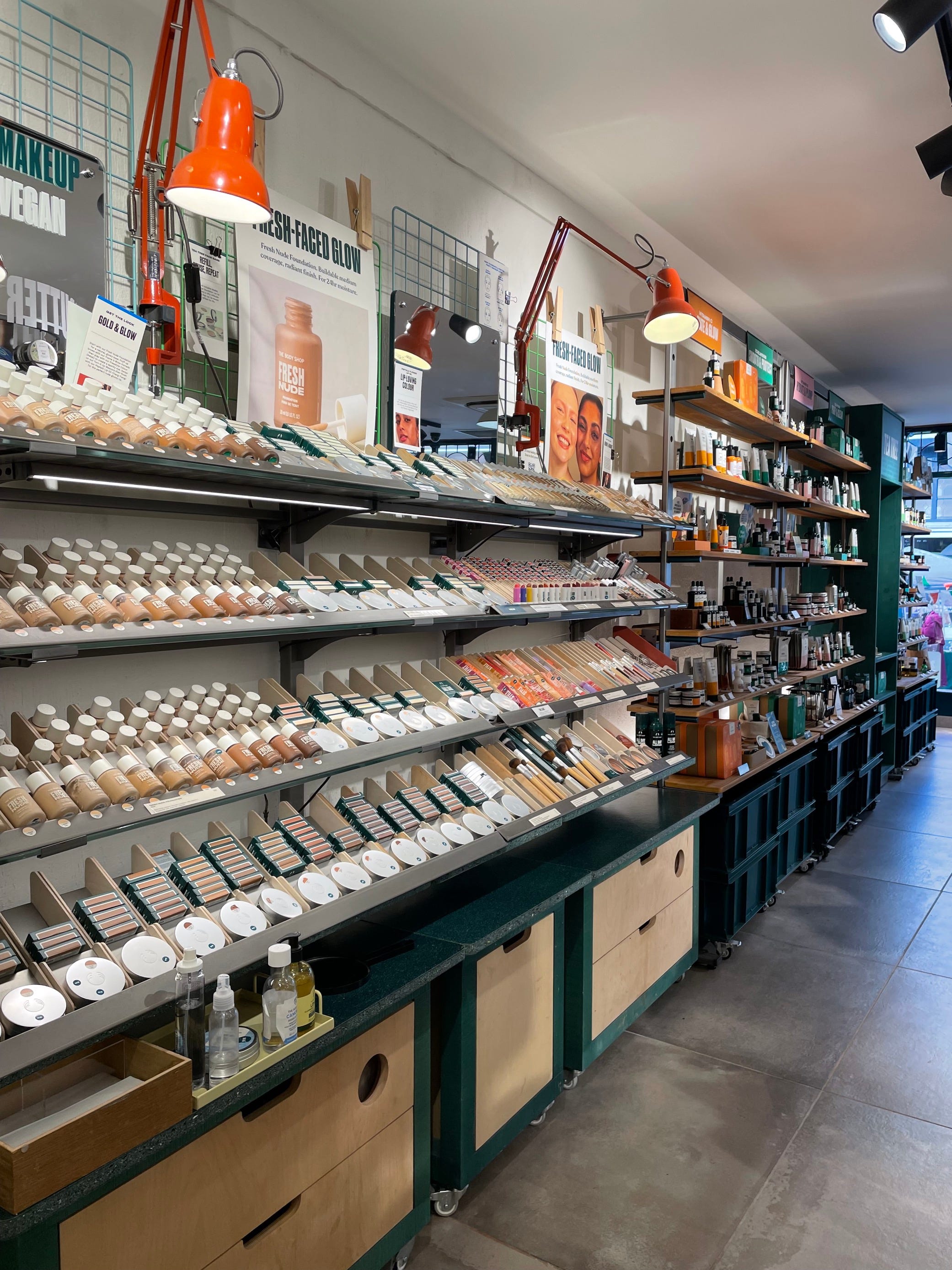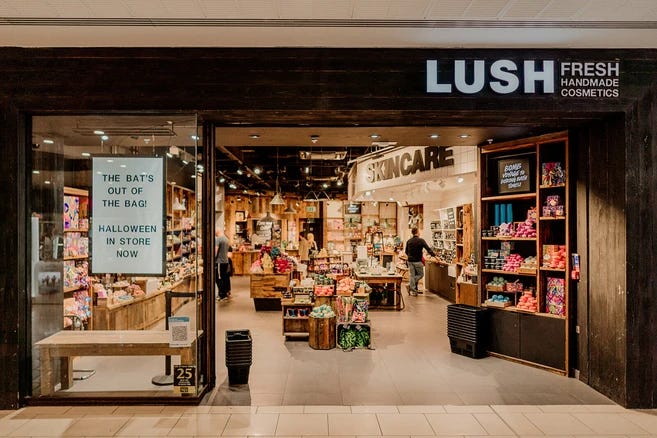
Unlike many who have written with sad nostalgia about early memories of the scent of a Body Shop. I have a slightly less fragrant (and of course true to my brand) more sceptical memory about Body Shop.
While I was working at P&G, my boss of the time was not a big Anita Roddick fan. His schtick on her and Body Shop went something like this: Roddick had established the brand on the basis of ethical activism and making a stand against the testing of ingredients on animals in particular. However, he believed she was essentially just working a loophole. Anita had discovered that there were enough ingredients already approved for use in skincare, so that she really didn’t need to get involved in the testing of new ones. These ingredients had typically been tested on animals in the past by industry suppliers. So in using them, she was still able to claim her company was against animal testing. He thought this was a sleight of hand, and that she ought to be obliged to amend her ‘Not tested on animals’ claim to be amended to: “Not tested on animals – tested on you.”
Timeline:
-
1976 Established by Anita Roddick with a single shop in Brighton, England,
-
1984 Listed on LSE valuing the company at £80m.
-
2006: L’Oréal bought Body Shop for £652m
-
2017 Sold for £880m in to Brazilian firm Natura
-
2023 Sold for £207m to private equity group Aurelius
-
2024 Body Shop’s UK business entered administration
First ‘Purposeful’ brand?
Established in 1976 by Anita Roddick with a single shop in Brighton, England, The Body Shop was a trailblazer in offering ethically produced skincare, haircare, and makeup. Roddick was the first notable advocate of sustainability and activism in beauty – a category beginning to come under scrutiny as ‘non essential’. This resonated with consumers worldwide. She championed natural ingredients, and pioneered eco-friendly practices such as refilling empty containers in-store (which she originally did at her first store in Brighton simply because she had run out.) Perhaps another opportunity to make a virtue out of a necessity.
If my P&G boss’s harsh analysis was correct, Body Shop could quite possibly be the first example of ‘fake brand purpose’. Even now, I’m undecided about this. I don’t really doubt Roddick’s sincerity overall, but I do think she was possibly being at least as much canny marketer as ethical crusader.
Human health or animal welfare?
The attitude of my boss at P&G might also have reflected P&G’s fear of being outflanked and out-marketed around a subject they were struggling to come to terms with. I know from conversations that took place at the time that managers at P&G were torn between what they saw as responsibility to people and responsibility to animals. They were still reeling from the affair of their Rely brand tampon and toxic shock syndrome. A plaintiff successfully sued P&G claiming that the Rely tampon was the cause of a fatal case of toxic shock syndrome. Unlike Body Shop, P&G pioneered the use of new technologies and materials, and were involved in other personal care categories than skincare and cosmetics. The company’s stance at the time was that there were things it had to test on animals to do their duty to ensure they didn’t harm humans.
It is interesting to note that all of the big companies in beauty moved away from animal testing quite early in the lifecycle of Body Shop. The turning point appears to be about 1990. Avon claimed to be the ‘first’ in 1989. L’Oréal hasn’t tested on animals since 1990.And in 2013, the EU introduced a blanket ban on animal testing on cosmetics. It is reasonable to assume that consumers didn’t get the memo. Likely the myth of animal testing remained because so many brands still made (and still make) the ‘Not tested on animals’ claim. When The Pull Agency surveyed 2,000 UK health and beauty customers in 2021, 13% of them thought that animal testing was the biggest challenge the industry faced. (60% identified plastic waste and recycle-ability as the number 1 issue so maybe Body Shop missed a trick there.) Nevertheless, Body Shop’s positioning clearly had legs, as the brand grew strongly on the back of their stance throughout this period.
Delights in-store

It also seems probable that the Body Shop stores played a role in building memory structures for the brand in brand adherent’s eyes (and noses). On hearing of the brand’s recent difficulties, a common comment is about a first experience visiting a Body Shop store. In at least the first phase of their existence, the store experience would have been novel and unusual. As one former Body Shop fan put it:
“I remember just loving Body Shop as a vibrant oasis of cool products with exotic ingredients that you couldn’t get anywhere else.”
The L'Oreal Era
Anita Roddick bailed in 2006. Just before she tragically died of a brain haemorrhage in 2007, she sold out to L’Oréal . It’s difficult not to see this as a turning point for the brand. Anita Roddick was the very high profile founder/owner of the brand, and many brand buyers saw this as a sell-out. They really bought into her as much as they bought the brand. But both Roddick and L’Oréal didn’t see it that way. Anita defended her controversial decision, however, explaining:
"The campaigning, the being maverick, changing the rules of business - it's all there, protected. And it's not going to change. That's part of our DNA. But having L'Oréal come in and say we like you, we like your ethics, we want to be part of you, we want you to teach us things, it's a gift. I'm ecstatic about it. So I don't see it as selling out."
In retrospect I think that whatever the good intention of both parties, Anita had pioneered either a kind of novel ethical approach in the category or clever marketing (or both) and it was likely L’Oréal would struggle to progress the brand without her. In addition, while they are undoubtedly masters of health and beauty brand marketing, L’Oréal had no experience in running retail stores.
But it would be wrong to suggest that L’Oréal neglected Body Shop. Perhaps ‘struggled with’ would be a better term. Roddick sold the business to L’Oréal for £652m and it was sold 11 years later (in 2017) to Brazilian personal care group Natura for £880m. But for some customers the sell-out to L’Oréal was pivotal. Many believed that the brand was no longer the ethical force it used to be. They (wrongly) assumed that the business values must inevitably have gone out of the door with Anita. At the same time, dozens of other beauty brands were stealing Body Shop’s clothes. So much so that it reached a kind of saturation point, such that by the time The Pull Agency conducted consumer research on sustainability in 2021, consumers were seeing factors like sustainability and animal cruelty as hygiene factors. i.e. what they expected of beauty brands, but not what differentiated them.
Lush moves

But some brands did go further with the Body Shop concept. Noticeably Lush. If you champion something that exists beyond the intrinsic purpose of your brand – you will always be prey to someone who does it in an even more attention-seeking way. Lush picked up where Body Shop left off. Bolder, brighter, - more fragrant. . . more outspoken, more activist, but with a fairly similar proposition. At the same time, an accelerating number of youthful brands were also emerging to capture the attention of new generations – brands like Byoma, CerAVe, e.l.f. Milk Makeup, all who have an exceptional presence on TikTok in particular.
In the meantime as consumers seemed to be getting more blasé about ethics and sustainability, they were getting more demanding about efficacy and natural ingredients. They now wanted both, and would look critically at which brands could deliver.
“The Body Shop itself hasn’t really evolved its concepts but all its competitors have come up behind it and not only have the advantage of sustainability but some also have really beautiful branding,” said Diane Wehrle, CEO of Rendle Intelligence and Insights. “The Body Shop hasn’t actually deteriorated but it hasn’t moved.”
And yet in some ways it did. But not necessarily in the direction fans wanted. As one said to me: “When you walk into a Body Shop it could be 1992. But on the other hand, they no longer sell the things that we used to love then!”
Just didn’t progress
The Body shop brand lifecycle is complex. I rarely use the term lifecycle for a brand unless it has been through an obvious rise and fall like Body Shop. After all, we don’t talk about the lifecycle of say MacDonalds. The environment in which a brand operates changes over time. Regulations change, competitors try to steal your attention, consumer attitudes move. So every brand has to progress. As I’ve pointed out before, by the time you need to reposition your brand it might be too late. You need to develop strategies to keep you brand relevant, salient and competitive. A good brand should never die.
Body Shop’s problem was not really that it deteriorated, but as the world moved on around it, it failed to move too. So many people I talked to said something similar. There was quite a lot of re-arranging of the deckchairs – but most people felt that the impact of those changes was net negative. They introduced a lot of new products but seemed to discontinue the most popular. They invested in in agency sales (MLM), but didn’t really see it through. They spent big sums on fancy store re-vamps. They got caught up in a drive to become vegan, but many customers felt that was to the detriment of the product quality. And some customers we spoke to thought they started charging luxury price points.
The consensus appears to be that the overall problem at Body Shop was a failure to move on. However, as that is a little vague as an analysis, I am going to try to identify the specifics of what that could be broke down into, and then – more difficult as no-one I have spoke to has really given me an answer – what should they have done?
What mistakes did Body Shop make?
-
Focussed more on ethics than efficacy. OK this might be controversial. But the personal care industry is currently experiencing the death of ‘brand purpose’. That is the attaching of un-adjacent progressive causes to the purpose of brands (e.g. ‘human rights’ to skincare.). Anita Roddick was arguably the pioneer in this. It worked very well for her perhaps because she was a genuine shock to the system – even if my P&G boss thought it was a bit insincere. The problem with ‘purpose’ in the long run, is everyone else can make similar ethical claims and your brand is no longer distinct for it. And there is very little you can do to respond. Perhaps Body Shop has bookended the era of brand purpose.
-
Not developing product formulations for a more educated and discerning consumer. Over the decades consumers have become better at diagnosing their own skincare challenges, and understanding what active ingredients work best for them. Many now start a product search with an ingredient e.g. “hyaluronic acid”. Google Trends shows this clearly. Body Shop formulations and ingredients looked dated according to some I spoke to compared to category upstarts and even more natural products. Aesthetician and beauty brand developer Alicia Lartey agrees: “In 2024, we expect much more from our skincare; we especially want to understand the science behind ingredients, the proven benefits and exactly how a product works.”
-
Fixating on the need to be vegan. The Pull Agency’s 2021 consumer research listed being vegan as 12th in a list of characteristics consumers want from a health and beauty brand.
-
Being seen by next-gen consumers as their ‘mum’s brand’. Health and Beauty is a faddish, trend-driven category. Purchase motivations are emotionally and herd-driven. New generations want new things to talk about and identify with. Trusted and established brands have to hold the fort, but they have to innovate, refresh and renew. They have to come across to a new generation of buyers as fresh, salient and relevant. Lush was almost purpose-made to steal Body Shop’s birthright in this respect. They succeeded as a kind of re-invented Body Shop because Body Shop didn’t re-invent itself.
So what should Body Shop have done?
I have imagined a scenario where Body Shop asked the Pull Agency what they should have done maybe a couple of years ago. Everyone and anyone will have a view on why Body Shop faltered, but at Pull we know only too well what it’s like to share the client’s burden and try to develop strategies that will progress the brand. Here’s what I think we would have said:
-
Do research on why your customers buy from you and why those that don’t, don’t. I won’t dwell on this as I expect Body Shop did consumer research and don’t know what insights it could have revealed. But we are always amazed by the large brands we encounter who have done little or no research. I would be more certain about the following if I was able to read their research!
-
Innovate and strengthen claim around the core platform of ethics. If your competitors are encroaching on your turf, put some distance between them and your brand. Focus on the things that really matter to your customers (in our research, innovation in packaging and recycle-ability is three times more important to consumers than being vegan). Anita Roddick (inadvertently) pioneered refills. Why couldn’t Body Shop have been the radical pioneer here? And what about moving the sustainability conversation on? And why not keep the focus on being the first to take an ethical stand: “First to care”.
-
Refresh the brand identity. Many commentators described the Body Shop brand identity as looking a bit tired and usurped by start-ups with the same ethical approach, but with “beautifully crafted branding and packaging”. Again, rather than ‘re-brand’, Body Shop could surely have given the by now undistinguished-looking identity and packaging a make-over? A great role model here is Tiffany. Faced with the same dilemma of an aging customer base it responded in very bold fashion with its ‘Not your mother’s Tiffany’ campaign. It knew it would ruffle feathers among its’ traditional clientele - and it did. But it also sent a clear message to their daughters.

-
Focus on efficacy and science in terms of ingredients and formulation as well as ethics. The two are not mutually exclusive. Health and beauty customers now want it all – this includes proven results as well as responsibility in terms of the environment.
-
Develop messaging campaigns to keep the brand salient and relevant. Body Shop was founded on a platform of activism when that was a very radical thing to do. But this is something else that surely needs progressing? The Pull Agency’s research suggests some consumer fatigue with the same progressive causes that so many brands have jumped on - and growing scepticism about ‘green-washing and ‘woke-washing’. Body Shop was supporting them all: Body positivity, LGBTQ+, Animal testing, Climate alarmism. Our 2022 research showed that almost 79% of health and beauty customers are wary about brands supporting what they now consider ‘woke’ causes, 10% will actively avoid brands they think are doing this. 59% said that they just wanted brands to ‘Pay taxes, treat people fairly and respect the environment.” Body Shop was setting the agenda in 1976. By 2023 it seemed to be very much following the agenda.
I suspect that Body Shop will continue in some form. But the problem has become existential. They have reached the point where the brand does need repositioning. But the means to invest in that will be hard to come by. The Pull Agency could help - give us a call!
Posted 13 March 2024 by Chris Bullick